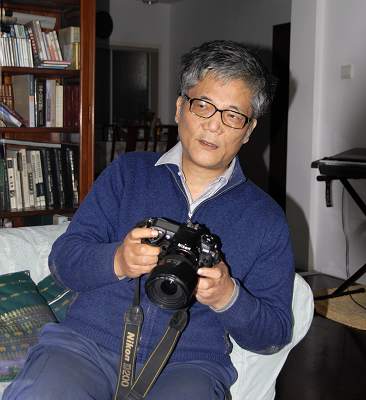|
 |
|
Chen Cun (LV LING) |
Shanghai writer Chen Cun, 56, has unique feelings about his hometown. "I hardly sense anything exciting, probably because I've lived here too long," he told Beijing Review. "The local culture is all around me, so I might not even be aware of it."
But for visitors who want to experience the real Shanghai, Chen has a suggestion. "You'd better spend two or three days trying local life in a narrow lane if you are really interested in Shanghai," he said.
Surely, Shanghai deserves more than a short stay.
The changes
Chen has witnessed Shanghai's development over the past five decades without interruption, aside from several short trips outside Shanghai and a three-year stay in the 1970s in nearby Anhui Province as a zhiqing (literally educated youth, referring to millions of young people who during the "cultural revolution" from 1966 to 1976 volunteered or were forced to work in the countryside under a directive from China's then leader Mao Zedong).
Today's Shanghai is a bit different from that in Chen's childhood memories. For instance, a tour of the Shanghai Zoo in the western outskirts, some 12 km away from the city center, was considered quite a hike for students back in the 1960s, while it takes only a 30-minute drive today.
"The city is making progress, but it turns out to be a bit strange [to its residents]," Chen said.
According to Chen, the original boundaries of Shanghai refer to today's inner city center, which is surrounded by Zhongshan Road. Two larger ring roads, namely the central and outer ring roads, now encircle it.
The city grew bigger and bigger as nearby towns and counties merged into new districts under Shanghai Municipality. For instance, the Xujiahui Area, the gateway to the city center and former bus transfer stations in the 1970s and 1980s, has become a booming business area featuring hi-tech digital products.
Transportation networks have developed rapidly in parallel with city expansion. Narrow lanes were replaced by roads; more subway lines were opened and linked with one another. The newly built high-speed railways and the Pudong Airport provide easier access to other places.
The changes in Shanghai, positive or negative, in Chen's eyes, have had a subtle influence on its residents then and now. By the same token, every detail of life and the way people view Shanghai have changed, too.
Although real-life scenes like street snack peddlers have gradually faded away as part of the price paid for the city's development, Chen said Shanghai people are very quality of life oriented. For instance, home decoration in the 1960s and 1970s—when four or five people usually lived in a house with an area of less than 20 square meters—remains pleasant and clean today. Local women, rich or poor, dress themselves in style at minimum cost.
Locals used to buy food before going to work because it was only available in the morning market. "It would have been hard to imagine today's all-day food supply, not to mention 24-hour stores," Chen said.
How to make it better?
Urbanization is becoming the main method of social development around the globe as rural people flood into cities in search of better lives.
Naturally, urban residents hope their lives will become better and better. But cities themselves face a dilemma. For instance, some 20 million residents in Shanghai consume various resources and produce huge amounts of garbage every day.
The theme of World Expo 2010 is "Better City, Better Life." "What we really need to think about is how to improve urban life," Chen said.
City construction, in Chen's view, should not focus too much on instant profit at the expense of long-term development, as the city will record every detail, good or bad, from its constructors.
Chen truly appreciated London, where many century-old buildings are well preserved. Unfortunately, many old villas with gardens in Shanghai have been demolished and renovated.
"I think keeping the old buildings as they were is more meaningful than renovation," he said.
Transportation and housing are basic elements of a city. But when a city expands, the growth in population and smaller space between buildings start to compress personal space, which causes a feeling of constraint.
When a person in a jammed-full subway has a fight with other passengers on the way to work, his or her bad mood will probably last for the rest of the day.
"The happy and unhappy moods that are intertwined between the city and its people are regarded as the weather vane for the changing quality of life," Chen said. "A better relationship among individuals will make a difference for the city as a whole. So we should concentrate on details to make urban life better." |